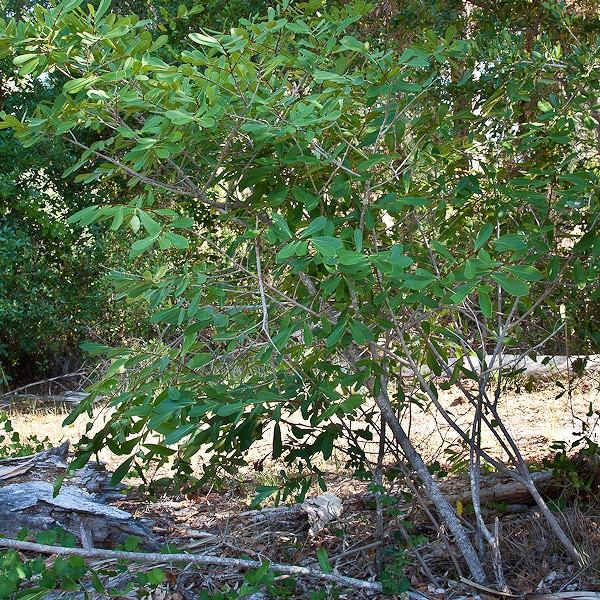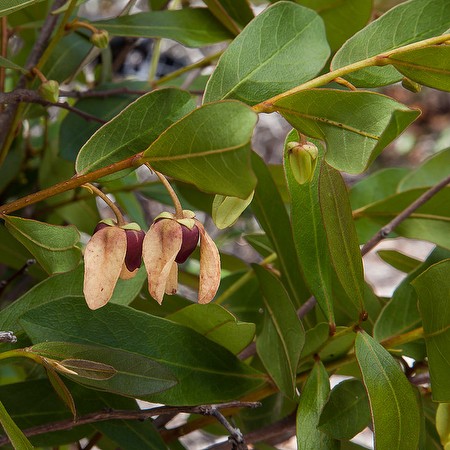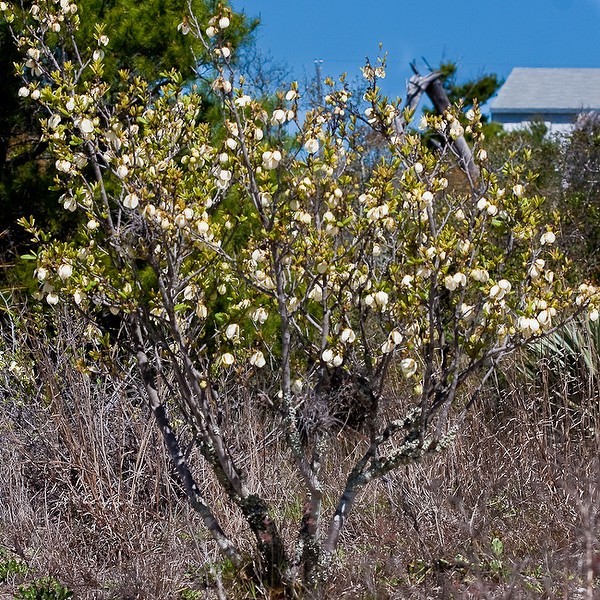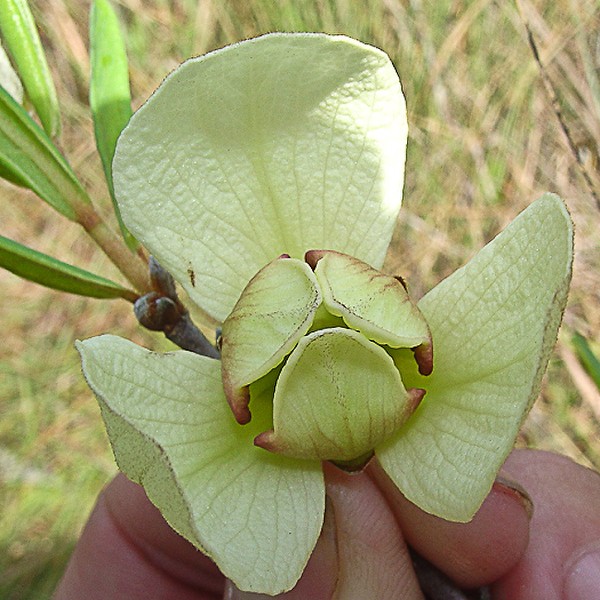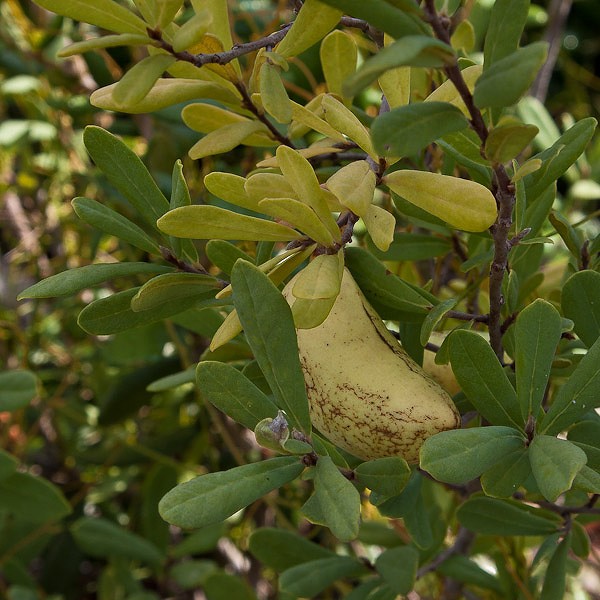PawPaws
Asimina species
Annonaceae
My best memories of my father come from his profound love and knowledge for nature, but even the sweetest memories can have PawPaw problems. My family lived in West Virginia, home to magnificent Pawpaws (Asimina triloba) 20-30 or more feet tall rising from the sides of shaded ravines and stream bottoms. (Where did the repeated Google-assertion that Asimina tetramera is the tallest pawpaw in North America”come from? Asimina triloba is much larger. I thought they couldn’t put anything on the Internet if it isn’t true.) My Dad told me, somewhere around age 8, ca. 1959, that PawPaws are tasty treats, so I sampled one out on the hillside where a burning coal slag heap looked and smelled like Hell surfacing. Within seconds after munching the “mountain banana” I was unconscious, to wake up a few minutes later in a pool of my own vomit. For the subsequent 53 years and to this day I can’t smell a Pawpaw without having my stomach flop. Was the PawPaw green and mean? (I can’t remember.) Was it an allergic reaction? Perhaps. Here is a tidbit lifted from Google:
“Allergenic responses have been observed. While many people enjoy the taste of pawpaw, some individuals can become sick after eating the fruit. Skin rash, nausea, vomiting, or diarrhea can develop…Many tissues of this tree, especially bark, leaves, and seeds, contain a variety of alkaloids such as the aforementioned acetogenins, as well as phenolic acids, proanthocyanidins, tannins, and various flavonoids. Though these compounds represent potential commercialized products as anticarcinogenic and botanical pesticides, they also can cause allergic reactions.”
The name PawPaw is confusing, applied also to Papayas, so be sure we’re talking about the approximately 10 species of the genus Asimina limited to North America, half of them limited to Florida as scrubby shrubs. The species have a long-known history of hybridization, yet, with that in mind, a surprising freedom from the taxonomic rearrangements often encountered with rampant hybridization.
PawPaw flowers are odd, and sometime showy. I’ve seen them misidentified as Orchids, although quite a stretch, the error is understandable. Traditionally regarded as primitive, the blossoms tend to be unusual for Dicots in having sepals and petals mostly in multiples of 3. The stamens and pistils are numerous and separate, with the pistils pollen-receptive before the anthers of the same flower release pollen.
What’s more interesting is that the flowers are generally regarded as beetle-pollinated, a slightly unusual and “primitive” characteristic. As with other beetle flowers, they tend to be cup-shaped and they can smell funny and fermented, although highly varied, and no doubt delightful to a beetle. Crawling around in the scrub sand Friday John and George found a beetle within the flower of a Four-Petal PawPaw. PawPaw flowers combine various shades of white, purplish-reddish tones, and greenish-yellow. The petals can increase in size and can change color after the flower opens, to the point that the same individual seen at different phases could pass for two different species.
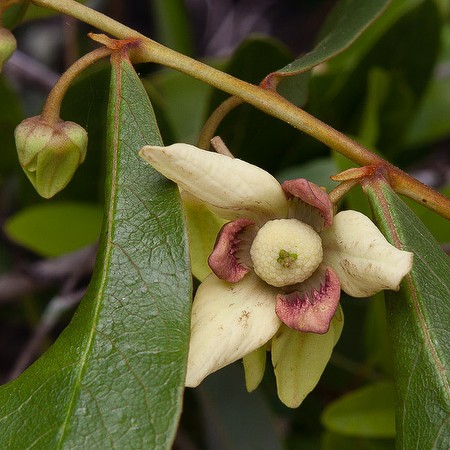
We opened the flower with a little force for a clear view (by JB). The lumpy white ball at the center is a mass of stamens. The green structures poking out at the center are pollen-receptive stigmas.
Four-Petal PawPaw is one of the two species scattered in our usual working radius, in fact, its entire worldwide distribution almost matches our usual working radius along central-south coastal Florida. How many federally listed endangered species do we have restricted to that zone? CLICK It’s easy to recognize in the field because somebody has usually affixed blue flagging tape to it. Don’t trust the name “four petal” PawPaw because names can lie, and the distinctions between sepals and petals can be confusing too. Premier Florida botanist John Kunkel Small named the species in 1926. He might have missed this critical reference: CLICK
As with many rare and endangered species, I worry about too much love almost as much as I worry about too little attention. Rare species have unique and interesting population structures and genetic patterns with respect to their odd distributions. And this is especially true as DNA study allows high-resolution analysis of genetic-distributional-relationship histories. Thus sometimes maybe propagation by botanical gardens and reintroductions of clones might mix up some delicate evolutionary genetics. So call me a grumpy silly old worrywart nervous nelly.
The other species abundant in our botanical sandbox is Reticulate-Leaved PawPaw (Asimina reticulata) often encountered with big white floppy flowers on leafless (or leafy) stems poking up from the scrub sand. The fruit can look like a bloated banana and certainly must be pleasing to wildlife. Even tiny wildlife can join the “feast,” because the individual seeds have their own pulpy attachments (called arils). (However, personally I’ll take a raincheck.)

